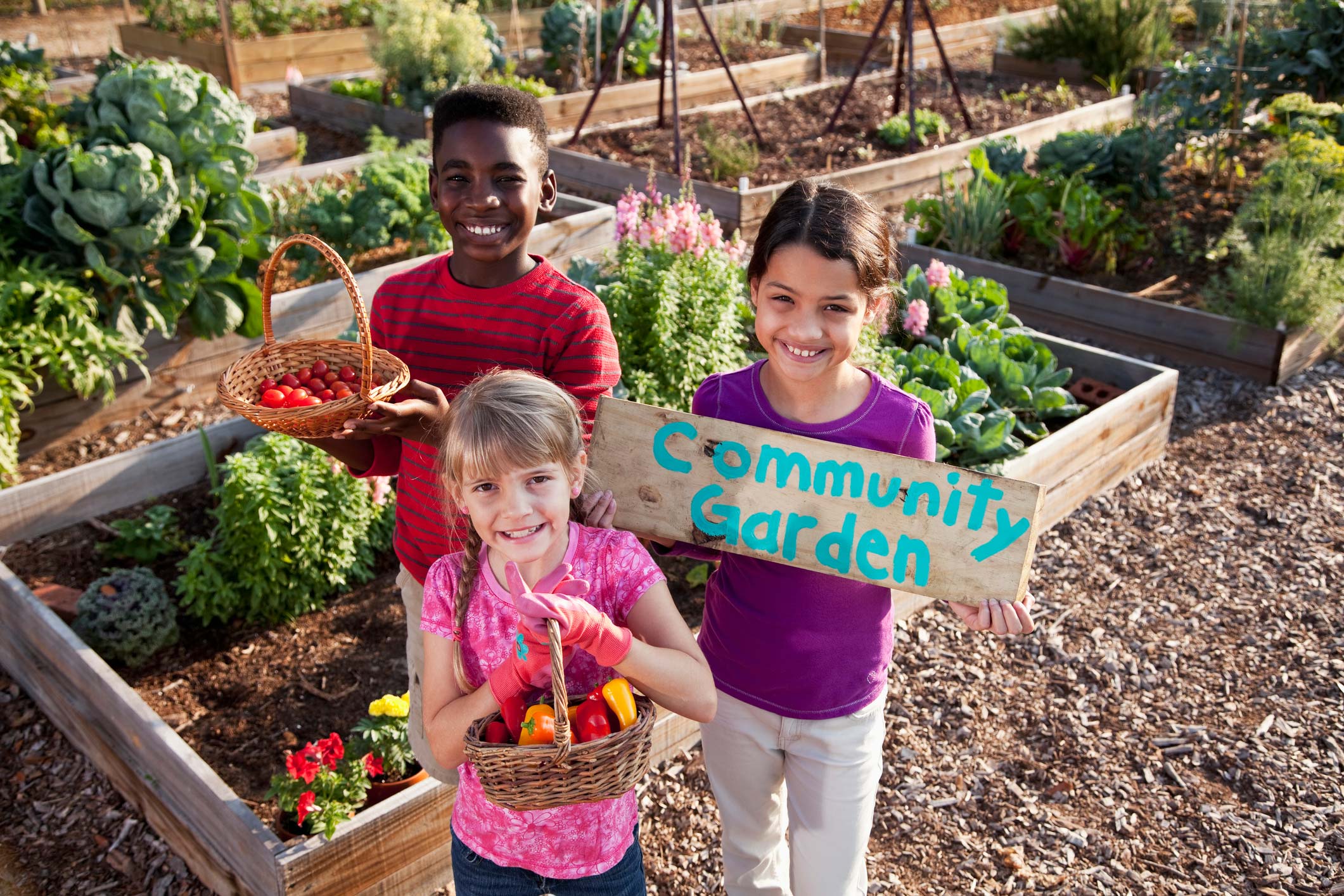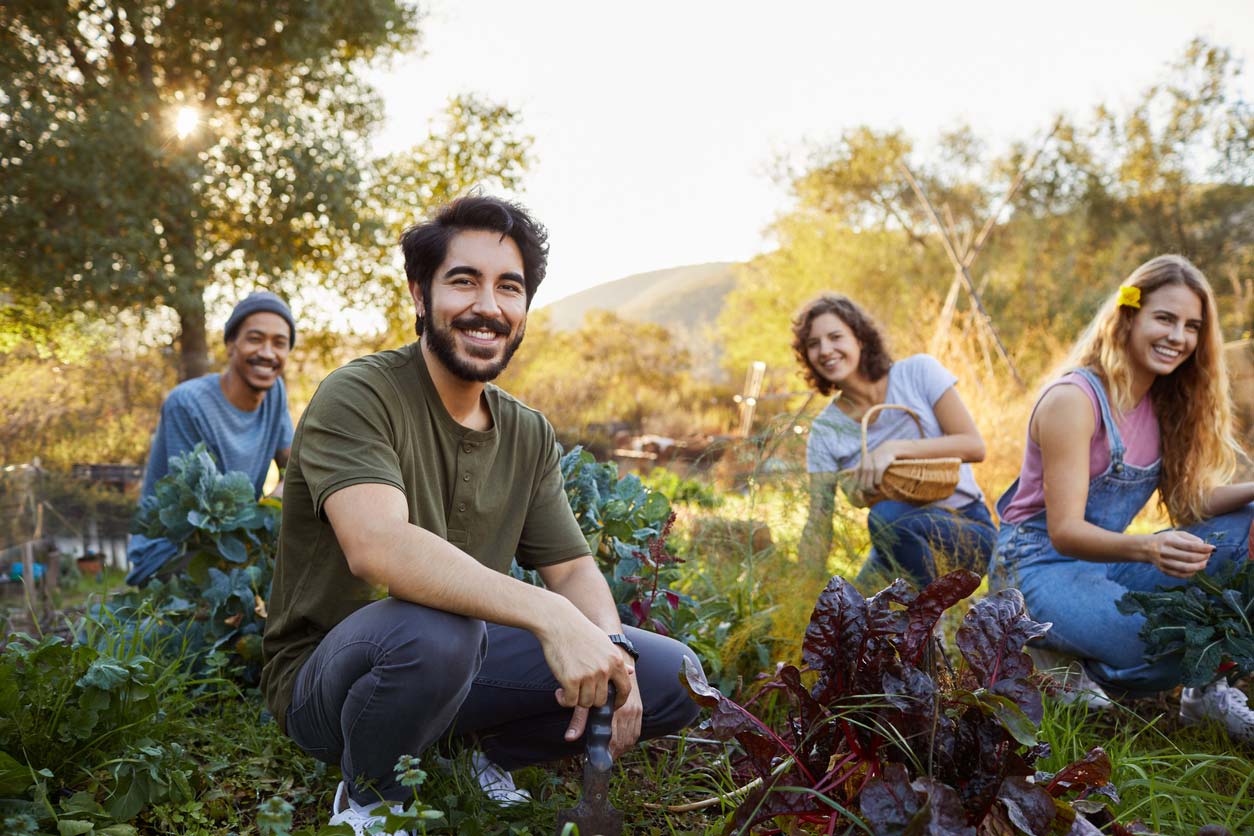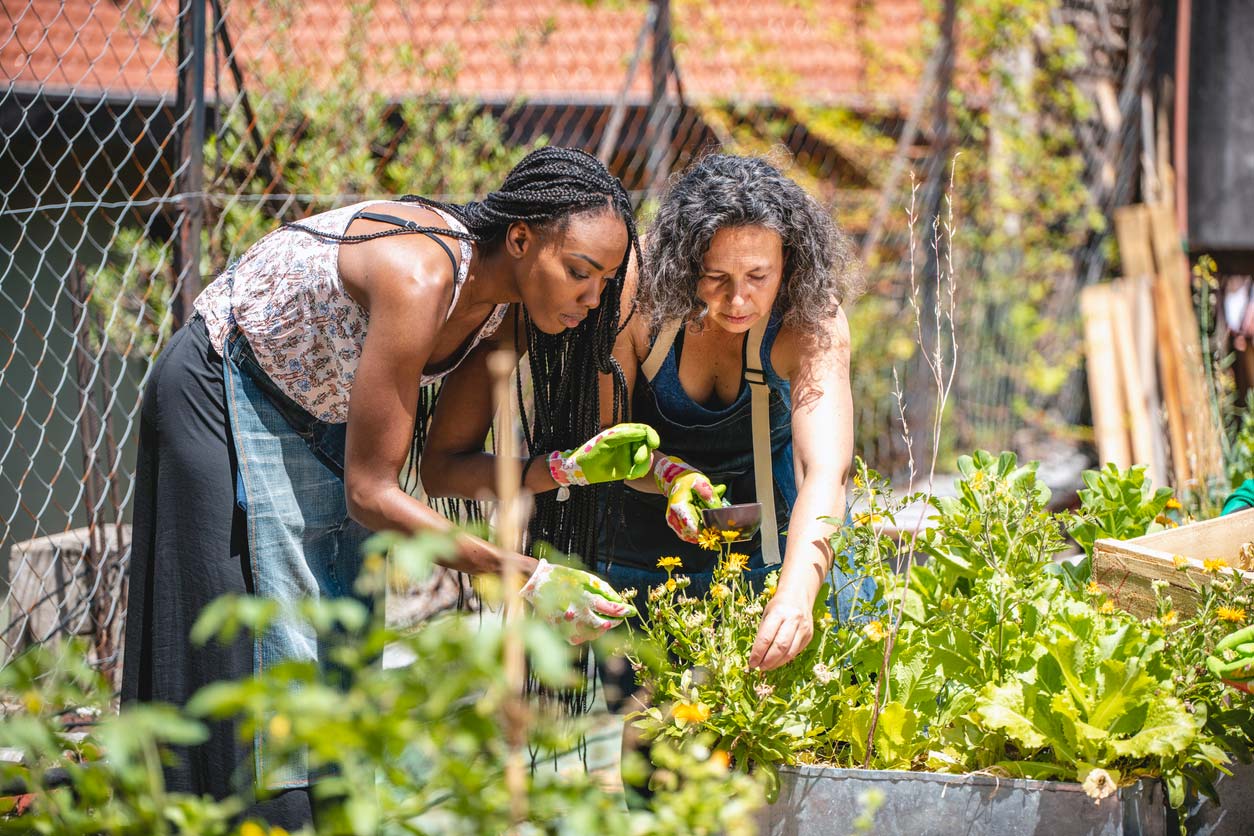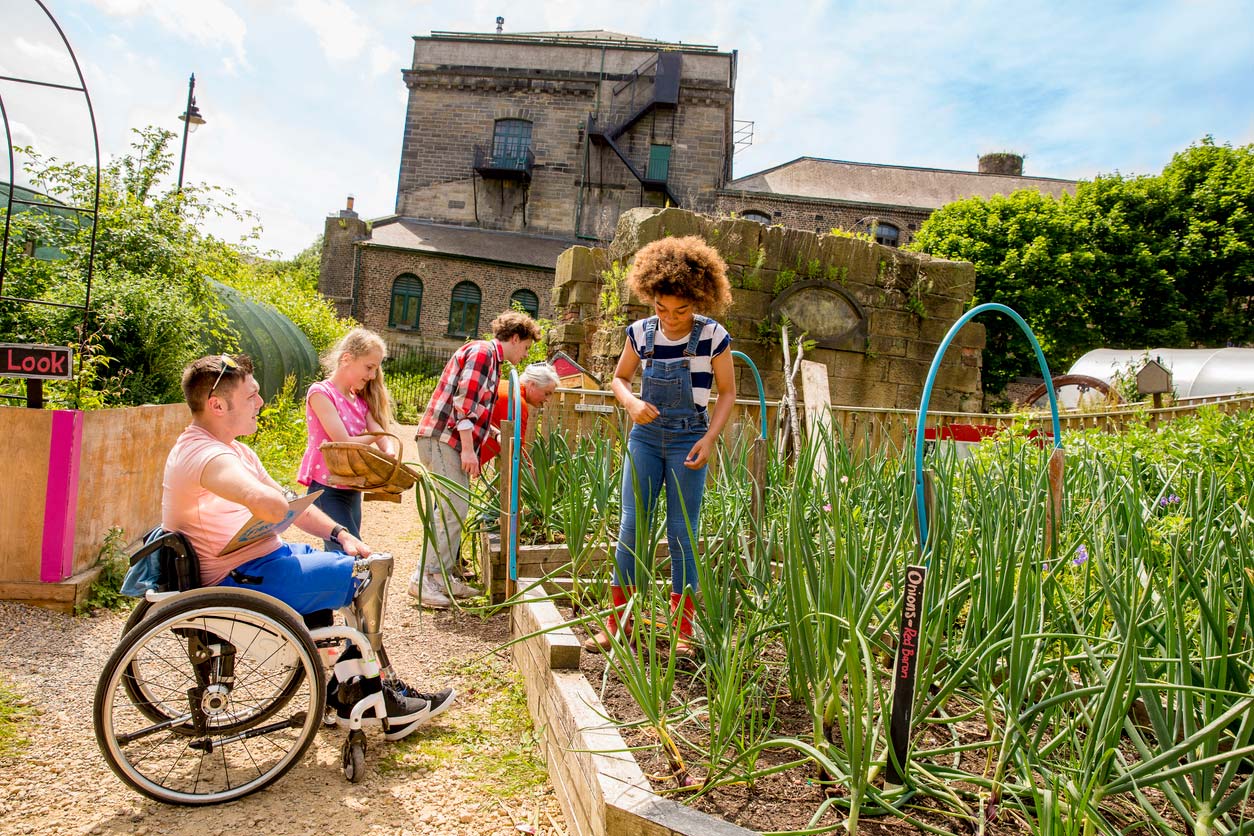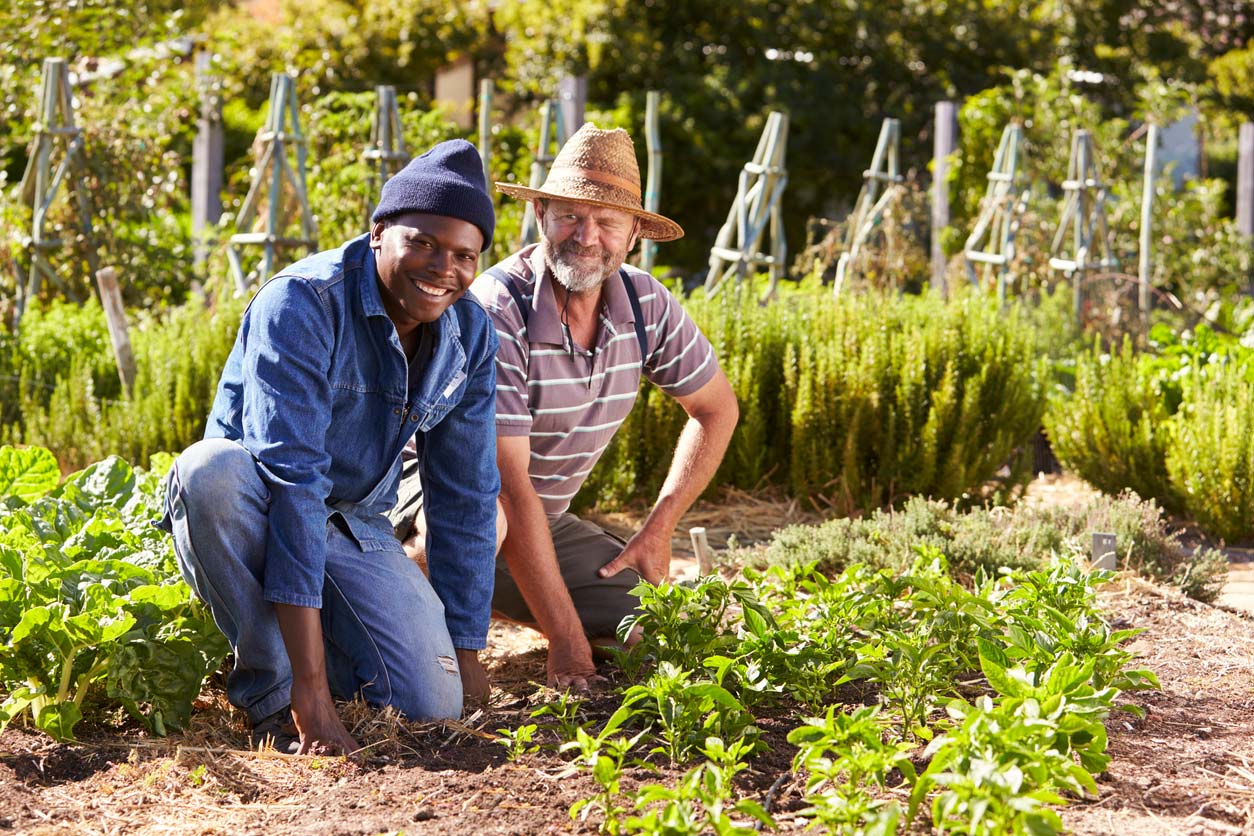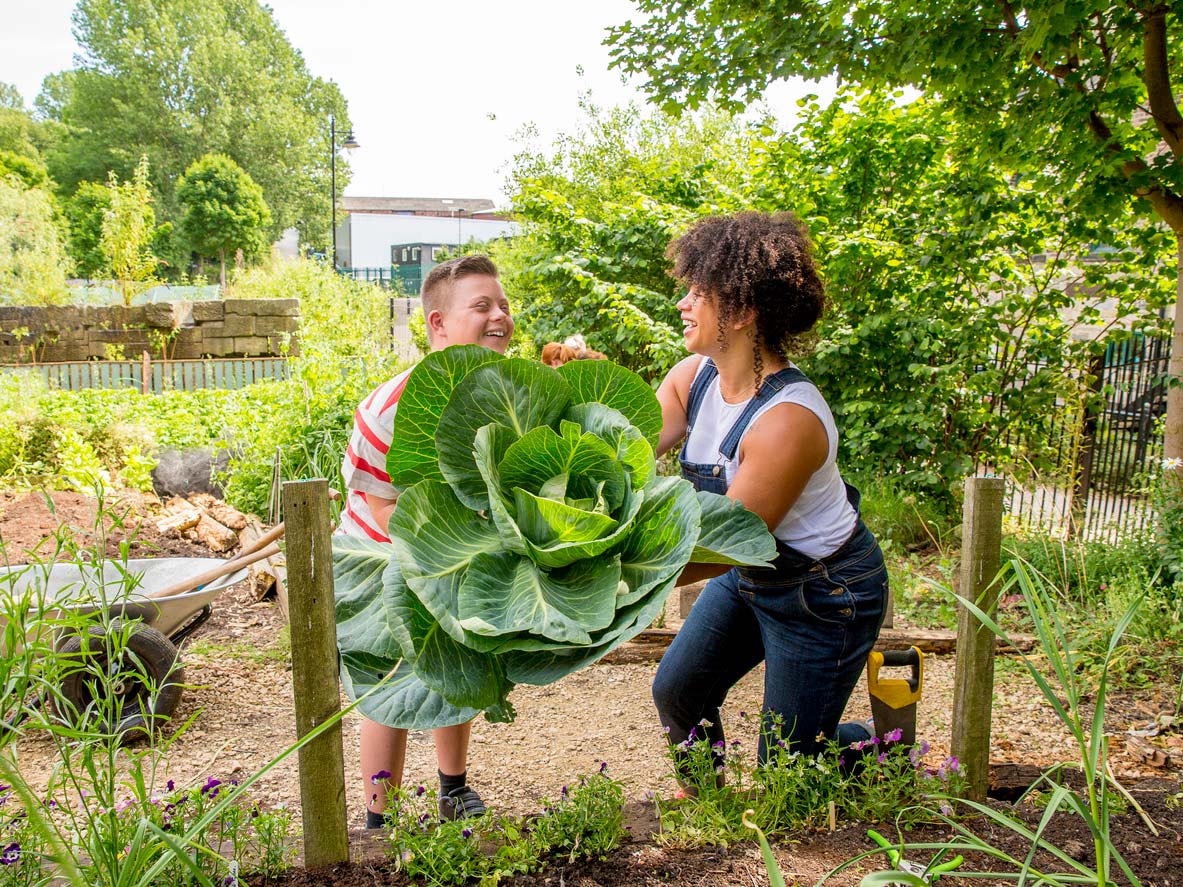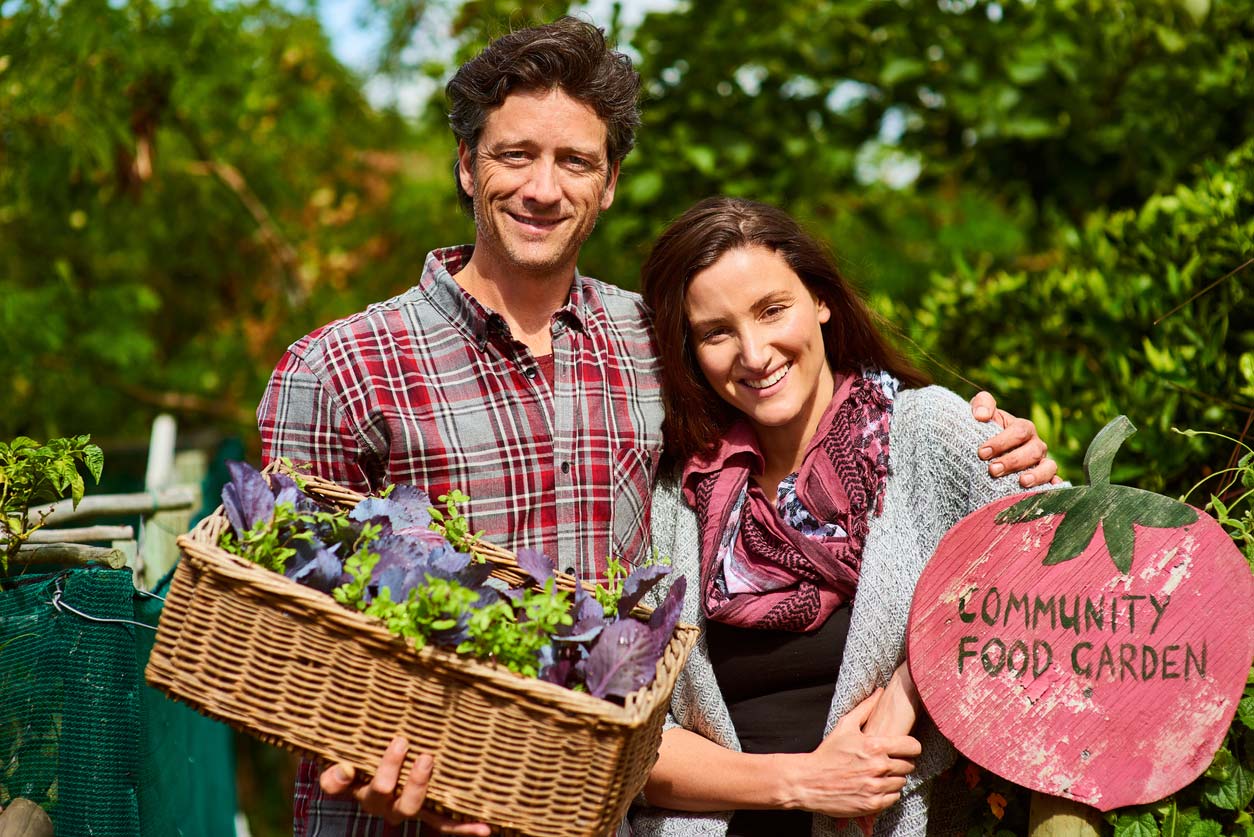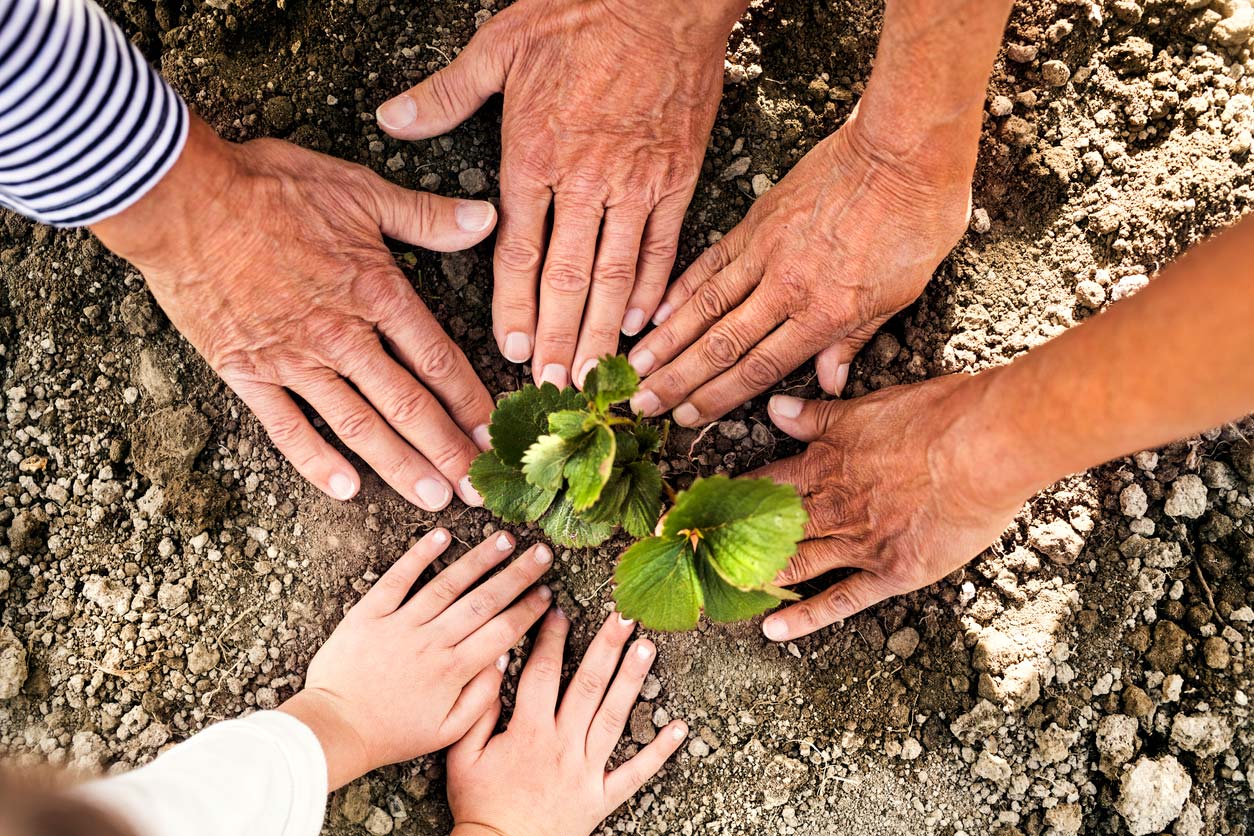Here’s a quote I love from permaculture founder Bill Mollison: “All the world’s problems can be solved in a garden.”
Hyperbolic? Maybe a little. But consider the problems you’ll find in parts of many cities: unlivable wages; lack of access to healthy food, and the poor health outcomes that come from that; water and air pollution; and struggling families, communities, and economies. I’d argue — and there’s plenty of research to back it up — that community gardens can help address all of these.
And it’s not just in urban areas. Community gardens can work wonders in suburbs and rural areas as well.
In this article, we’ll look at what community gardens can accomplish, and offer some ways for you to get involved in this growing (pun intended!) movement.
Why Gardening?
Throughout history, humanity has instinctively turned to gardening when faced with insecurity and turmoil. So it’s not surprising that with the onset of the COVID-19 pandemic in 2020, Americans turned to gardening in record numbers, leading many seed suppliers to run out of seeds.
Food shortages experienced during the early days of the pandemic prompted many people to pursue more self-determination over their food supply. Others became more concerned about food safety, or wanted to have more control over exposure to GMOs, agricultural chemicals, and unnecessary additives in their diet. Many simply wanted a new way to provide healthier food for their families.
Growing your own food also has additional environmental benefits, allowing you to eat locally and reduce your carbon footprint. In a tumultuous, ever-changing world, many of us have rediscovered the peaceful refuge, security, and purposeful activity a garden can provide.
Healthy Food Access for All
Let’s start with the most basic feature of a garden: it provides food. And fresh, nutritious food at that. This factor alone means that gardens can not just help alleviate hunger, but improve health in marginalized communities. Poverty status is a risk factor for poor health. And some low-income areas in the US have an average life expectancy that’s many years less than that of the national average, or even the higher-income communities nearby.
And living in a low-income community also often means there’s a greater need for and dependence on public transit, which leads to longer travel times to get healthy food. A four-mile commute to a grocery store can turn into a multi-hour endeavor on a local bus or subway, making corner stores like 7-Eleven a time and money-saver, despite their lack of healthy options.
All of this is compounded by additional food access issues that make healthy eating more difficult for lower-income individuals and families. For example, in the US, many unhealthy foods are made with subsidized ingredients. Government subsidies of “commodity” crops like corn, soy, and wheat bring down the price of things like white bread, high fructose corn syrup, and factory farmed meat while also creating a marketplace distortion that makes fruits, vegetables, whole grains, and nuts and seeds comparatively more expensive.
But community gardens can help here, too, by bringing healthy food into the very communities that need it the most, reducing reliance on convenience stores and fast food. And as we’ll see, the benefits don’t end there.
What Is a Community Garden?
But before we dive into all of the things that make community gardens great, perhaps it would benefit us to define what exactly a community garden is.
The term “community garden” refers to land or a garden tended to by a group of people. It may be divided into individual or shared plots. Community gardens can either exist on private or public land, within a community, neighborhood, or on the grounds of an institution such as a church, school, city hall, or hospital.
Primarily used for growing edible plants for the surrounding community to enjoy, community gardens also engage members in the process of growing and harvesting crops. Produce in community gardens is generally grown for personal consumption, or even for sharing, but donation and/or sale of crops are also possible.
Churches, non-profit organizations, individual community members, neighborhood associations, clubs, cities or counties, or other community-level agencies often establish community gardens.
And while community gardens are often associated with urban gardening and the transformation of vacant and abandoned pieces of land, this isn’t always the case. For instance, rural and suburban community gardens exist, as well. And unique floating gardens and rooftop gardens are also creative takes on community gardens.
Currently, there are over 2,100 community gardens throughout the United States and Canada registered with the American Community Gardens Association. And that number is likely to continue climbing as their popularity increases.
How Did Community Gardens Start?
Although community gardens may seem like a relatively recent trend, the idea of shared garden plots has been around for centuries. Allotment gardens in the UK and Europe set aside land plots to prevent starvation among those who did not actually own land. Use of the land wasn’t exactly free, however. Gardeners paid landowners or local authorities to rent the plots. And access was often based on adherence to strict rules. For example, anyone who dug potatoes on Sundays in lieu of church attendance would forfeit access to the land.
In the United States, community gardens came about during wartime, as the US government encouraged Americans to plant “victory gardens.” During both World Wars, the domestic supply of fresh fruits and vegetables expanded greatly thanks to community gardens. These kinds of gardens also popped up during other economic downturns and nationwide crises. During the Great Depression, for example, community gardens and farms helped unemployed workers and their families put food on the table.
But modern community gardening doesn’t necessarily follow in the footsteps of its origins. Now, there are a greater variety of reasons for starting a garden. There are societal concerns like the environmental impact of the commercial food system and urban degradation, in addition to using community gardens to beautify and improve the local environment. Community gardens also serve to bring additional resilience, food, and a source of connection to their neighborhoods.
Types of Community Gardens
Community gardens come in many different shapes, sizes, and locations. Below are some of the most common types of community gardens you might find.
Neighborhood or Residential Gardens
Neighborhood or residential gardens are just like they sound — located in a housing community or apartment complex. Edible landscaping on your own private property can also fall under this category. You can share food grown in your private garden with neighbors, or use it as a display plot to encourage others to abandon their lawns and start their own gardens.
Residential gardens may also consist of a shared space within your neighborhood, where members of the community can volunteer or help with upkeep. In these settings, members may take the produce they grow, or they may donate or sell it within the community.
Oftentimes, repurposed vacant lots get a makeover into urban gardens, which has been the case at hundreds of locations in Detroit. In fact, many people now regard Detroit as the community garden capital of the United States. In the year 2000, there were an estimated 80 farms within Detroit’s city limits. And by 2017, there were more than 1,500, with the city’s urban farmers producing an estimated 400,000 pounds of fresh fruits and vegetables for city residents each year.
Allotment Gardens
Allotment gardens come from a single piece of land divided into separate plots and leased out to people for use. These are more common in places like Europe and the United Kingdom, and have a longer history, dating back to the 1700s. As mentioned before, these types of community gardens are often owned by the local government or self-managed and owned by the allotment holders through an association. Allotment gardens allow local families to grow their own food, which can be especially helpful if they don’t have any green space of their own.
School Gardens
Studies show that when kids grow vegetables, they eat more vegetables. And if they can do so in a learning environment, all the better.
School gardens are typically raised-bed gardens created for the benefit of a school. Students can take part in the process of setting up the garden as well as the harvesting of what’s grown there. They also get to learn about nutrition and plant identification in the process. In some cases, produce grown in school gardens may become part of school meals, snacks, or other creative uses in a classroom setting to give kids further hands-on experience with the end result of growing their own healthy, whole foods.
Demonstration Gardens
Demonstration (or demo) gardens highlight a variety of plant types, sustainable practices, and how to grow edible plants. In this setting, participants get to test out different plant varieties as well as techniques for growing them. Demo gardens are often the result of a city or university project, or a gardening extension program. And they may have a theme, such as a garden for native plants, herbs or medicinals, or gardens designed for children.
Institutional Gardens
Institutional gardens are edible gardens located and maintained either on private or government-owned property. City parks gardens, church gardens, prison gardens, or hospital gardens are all examples of institutional gardens. The institutions where these types of community gardens are located have the chance to connect directly with the communities they serve. Plus, it directly benefits the inmates, residents, patients, or congregations already involved.
Churches find that community gardens can deepen connections between faith, nature, and food. Prisons find them helpful with reform and rehabilitation programs. And hospitals find that they help patients make the connection between food and medicine.
One example of the power of an institutional garden to uplift a community is the Baptist Health system in South Florida. This chain of hospitals established a Grow 2 Heal garden at four of their hospitals located in low-income communities. The first one was planted at Homestead Hospital in south Miami-Dade County. In this area, 30% of the population is dependent on food stamps despite, paradoxically, being located in the middle of an agricultural zone. But now, the 10-acre hospital garden feeds not only local residents, but provides ingredients to the hospital’s kitchen, lowering the price of creating healthy meals for patients and hospital staff.
How Community Gardens Build Equity
Community gardens can bring a variety of social, cultural, environmental, nutritional, and financial benefits to those involved.
Bring People Together
Community gardens encourage community investment in a common goal, thus bringing people together who might not otherwise interact so closely. One of the natural outcomes of this is getting to know your neighbors, learning to look out for each other, and enjoying the added benefits of building new friendships and partnerships within your community. Community garden involvement can also help create an “all are welcome” atmosphere, where people of all ages, genders, backgrounds, and walks of life can come together and work side-by-side with diverse peers.
Plus, cleaning up vacant land and creating community gardens may even help reduce crime in the area. Research has shown that the simple acts of cutting overgrown grass and picking up trash in low-income neighborhoods can curb gun violence within metropolitan areas by up to 30%.
Improve Food Security
Community gardens also help address some of the problems with food deserts, areas where it’s hard or close to impossible to find healthy food. Many low-income communities are prone to food deserts, where there is also a prevalence of poor health outcomes.
The good news is that the creation of community gardens in these areas can lead to significant positive changes in people’s health and well-being. In places with food insecurity, community gardens can be a lifeline, helping to address hunger in many households. An increase in food security can occur when a community garden is within walking distance of residential areas, particularly in urban neighborhoods. Produce from a community garden can also help fill in gaps left when a food pantry or food bank can’t provide fresh produce.
Good for the Environment
Converting vacant lots into community gardens not only removes an eyesore, but can also help restore degraded soil that can become safeguarded for the production of food. Restoring soil quality and fertility also yields benefits such as increased carbon sequestration, reduced stormwater runoff, and improved water-holding capacity.
Green spaces like community gardens also have the added benefit of encouraging life to come back to an area. Pollinators, insects, birds, and other wild animals help contribute to a community garden’s growth, output, and stabilization of the environment.
There’s also a chance to improve air quality, decrease “food miles” and subsequent air pollution, and reduce neighborhood waste through composting.
Unfortunately, low-income areas tend to suffer disproportionately from environmental problems. In many situations, contaminants in urban soil come from industry, unauthorized dumping, construction, heavy traffic, and adjacent buildings that may have lead paint exposure. If you’re starting a community garden in an area that may have a history of exposure to pollutants, it’s wise to get the soil tested for lead and other possible contaminants (or build raised garden beds) to make sure it’s safe for growing food. Many local gardens work to restore soil, so it’s usable and free of contamination, using things like compost, organic matter, mulch, and mushrooms.
Offer Health Benefits
Community gardens are also great ways to improve community health. Eating more fresh produce is associated with better self-esteem, mood, and general health. People who enjoy fruits and vegetables often experience reduced stress and improved resilience.
And people who grow fruits and veggies themselves are more likely to eat fruits and vegetables. This is especially true of children, who are five times more likely to eat produce if they have a hand (or two) in growing them. Kids who grow up exposed to fresh produce and edible gardening have more familiarity with fresh, healthy whole foods. They know what different fruits and vegetables look like, taste like, and how to grow and prepare them — skills that will serve them for a lifetime.
Eating a diet that includes fresh fruit and vegetables has a positive impact on the gut microbiome, too. Feeding your gut well, and promoting a healthy balance of good bacteria, is key to supporting your overall health. Research shows that the composition of soil in which your food is grown can help increase the number of beneficial microbes in your gut.
Furthermore, physical activity is higher among people who garden. And according to some studies, gardeners tend to have fewer problems with excess weight compared to people who don’t garden — even among close relatives.
Growing Skills and Deepening Culture
Community gardens can also provide opportunities for skill-building, employment, and education. Many gardens utilize volunteers, but there’s also the potential for employment and internships for teens and adults alike — a fantastic opportunity for hands-on training and work experience.
Many communities are also using gardens to create opportunities for rehabilitation and skill-building for homeless individuals, veterans, and the disabled community. Community garden work has even been shown to reduce the likelihood of prisoners re-offending. For example, the Sandusky County Jail Garden reports that when inmates participate in the jail’s garden program, their odds of being rearrested drop by 55%.
Many gardens also host workshops and other classes on a variety of topics related to gardening and growing food, connecting with the land, sustainability, and cultural issues, which can provide further connection and personal growth. They can also play an important role in providing space to preserve and nurture the cultural identity of communities, fostering a sense of belonging and generating a sense of home among participants, while also helping them to adapt to a multicultural environment.
One example is the casitas, or small houses, in community gardens of the Lower East Side in New York City, which has helped the Puerto Rican community there connect with their heritage. Many tribal community gardens and farms — like the Indigenous Gardens Network — may also highlight the importance of educating members about ancestral foods and practices.
Generate Local Income
Community gardens can also bring in a little extra income for a community. Some gardens sell some of what they harvest at local farmers markets or through CSAs. And other community members can benefit financially by lowering the amount they have to spend at the grocery store or on food overall. What’s more, property owners may generate income by renting plots of land out for use as a garden.
Community Gardening Organizations to Support
If you’re interested in supporting community garden organizations that help make these gardens happen, here are a few to consider:
1. American Community Garden Association
The American Community Garden Association (ACGA) is a nonprofit grassroots organization that advocates for community gardening, whether it’s tiny pollinator pocket parks, school gardens, or urban farms. Founded in Chicago in 1979, it now has over 1,000 individual and 252 organizational members with involvement in 2,100 gardens. ACGA’s primary goal is to help community gardens spread across Canada and the United States and support greening. You can support their work by becoming a volunteer, joining their membership pool, or contributing a donation.
2. Cooperative Gardens Commission
Cooperative Gardens Commission is a grassroots collective aimed at achieving food sovereignty, including land access, resource sharing, government policy, education, and community organizing. It was founded in March of 2020 in response to injustices highlighted by the COVID-19 pandemic. You can offer your support through a one-time or monthly donation — or become a volunteer if you’re in the United States or Canada.
3. Each Green Corner
Each Green Corner is a 501(c)(3) organization founded by attorney Sandie Nierenberg. She saw a future where people share their spare resources to build strong, healthy, and sustainable communities — while healing the planet. The organization’s mission is to educate and assist community members in growing sustainable, permaculture-inspired, and culturally diverse food gardens, and then harvest excess produce for donation to local nonprofit food distribution partners.
Each Green Corners aims to bridge the gap between home gardeners and food distribution nonprofits to increase availability of fresh, nutritious, and culturally-diverse produce for local communities. If you’re interested in their work, they offer plenty of volunteer opportunities near and far, or you can donate to their cause.
4. Soul Fire Farm
Soul Fire Farm is an Afro-Indigenous-centered community farm located in Petersburg, New York. It’s dedicated to creating a sovereign food system, ending food apartheid, and uprooting racism. Part of their approach is to train the next generation of activist-farmers while also strengthening the movements for food sovereignty and community self-determination.
Soul Fire Farm’s programs reach over 10,000 people annually, including their Black and brown farmer training, food justice workshops, reparations and land return initiatives for northeast farmers, food delivery to insecure households, and policy education. To support Soul Fire Farm, consider taking one of their workshops (if you’re in the NY area), making a donation, or looking through their volunteer opportunities.
(Watch the video interview or read the transcript of my Food Revolution Conversation with Soul Fire Farm’s co-founder and co-director, Leah Penniman, here.)
5. Homeless Garden Project
The Homeless Garden Project is a nonprofit organization created in May of 1990, when the Citizens Committee for the Homeless, a Santa Cruz County nonprofit, opened the gates of an organic garden on Pelton Avenue. Its members work to provide job training, support services, and transitional and transformational skill-building work for the homeless population in Santa Cruz, California. Their current working farm is the Natural Bridges Farm, where they grow organic, seasonal vegetables that are then made available at their Farm Stand, through their CSA, and even at certain local restaurants. You can make a donation to the Homeless Garden Project or choose from a variety of volunteer opportunities if you live locally.
How to Find or Start a Community Garden
Looking to locate — or perhaps start — a community garden in your area? Here are some tips.
To find an existing garden, check out the American Community Garden Association database.
The University of Missouri also recommends these ten steps to bring your community garden from idea to success:
- Talk with friends, neighbors, and local organizations about your idea to gauge interest.
- Hold a meeting with anyone interested in the garden to determine the feasibility of making it happen.
- Find and evaluate potential garden sites by exploring the area in detail, considering possible partners and plots of land. If necessary, get the soil tested for lead and other contaminants.
- Identify local resources needed for starting a garden, like tools, infrastructure, knowledge, and supplies — and where these might be obtained.
- Hold a second meeting to discuss notes from your initial meeting and cover additional questions and issues that have arrived since then.
- Draft a lease agreement that outlines obligations and responsibilities of the parties involved.
- Develop a site plan that includes things like lot boundaries, water source, individual or shared plots, compost bins, storage and sheds, open spaces, and a garden sign.
- Establish gardener guidelines and draft the gardener application, which will include things like member fees and the application process, when your growing season will run, whether materials and tools will be shared, how pests will be controlled, guidelines for how to treat other people’s garden plots, and whether kids and pets are allowed in the garden.
- Prepare and develop the site, which will take time and require scheduled workdays, leaders, and collaborators.
- Celebrate your success! Throw a garden party for all involved to look at how far you’ve come and discuss plans for moving forward.
For a more comprehensive step-by-step to starting a community garden, check out this guide provided by the University of California Cooperative Extension.
Community Gardens Are Powerful
There are obviously a lot of problems in the world. And some days you may feel that the problems are just too much; that there’s nothing you can do. When I feel that way, I think about the last line of Candide, by Voltaire. After facing one disaster after another, and finding no support or solace in the philosophies of those he encounters, Candide ends his tale with a single realization: “We must cultivate our garden.”
Or, to paraphrase Edmund Burke, nobody makes a greater mistake than one who does nothing because they think they can do only a little.
One of the best things you can do right now is just to empower others to cultivate their existing gardens, so that the movement to take care of our planet and to take care of our own health, can spread and flourish across the globe. We can take responsibility for what is right in front of us, and make it grow into something strong, beautiful, and bountiful.
Tell us in the comments:
- Do you have a community garden in your neighborhood?
- Have you ever participated in the start-up of a community garden?
- If so, what benefits have you observed or personally experienced from having a community garden?
Feature image: iStock.com/kali9
